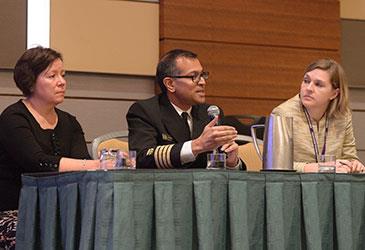The Centers for Disease Control and Prevention (CDC) estimates that 2 million U.S. illnesses and 23,000 deaths each year are caused by antibiotic-resistant infections, and these result in an estimated $20 billion in excess health care costs. Three CDC experts spoke to physicians at the 2015 AMA Interim Meeting about this global health crisis and multifaceted solutions to address it.
Education and communication can curb antibiotic overuse in outpatient settings
A major factor in the growing problem of antibiotic-resistant infections is overuse of antibiotics.
Trained as a pediatric-emergency medicine physician, Katherine Fleming-Dutra, MD, said she understands the importance of curbing antibiotic overuse in the outpatient setting. She’s now a medical epidemiologist for the National Center for Immunizations and Respiratory Diseases at the CDC.
In 2011, “providers prescribed 842 antibiotic courses per 1,000 population in outpatient settings,” Dr. Fleming-Dutra said, noting that researchers estimate that roughly 80 percent of antibiotic use in the United States occurs in outpatient facilities.

“To put that into context, that’s more than four antibiotic courses for every five people in the U.S., which totals to more than 263 million antibiotic courses per year.”
Dr. Fleming-Dutra said physicians commonly cite concerns about patient dissatisfaction as a major reason they overprescribe antibiotics. Yet she noted that research shows “patients are actually still satisfied if they don’t get antibiotics, even if they want [them], but they are dissatisfied if their communications expectations aren’t met.”
This is why she recommends communications training for physicians around antibiotic use, so they can understand patient expectations, comfortably explain to patients why their particular health condition does not require antibiotics and offer an alternative treatment.
She also suggests that physicians partner with initiatives such as the CDC’s Get Smart campaign, which focuses on educating health care providers and the general public—often in community and outpatient settings—about proper antibiotic use.
The Get Smart About Antibiotics Week is currently underway, Nov. 16-22. Learn more about how you can get involved.
Fighting back with antibiotic stewardship programs in inpatient settings
Arjun Srinivasan, MD, associate director for Health Care-Associated Infection Prevention Programs at the CDC, agrees that interventions offering physicians educational resources and a robust infrastructure for monitoring antibiotic use can reduce the spread of antibiotic-resistant bacteria—particularly in the inpatient setting, such as hospital and nursing homes.
“Stewardship programs in many studies have demonstrated [the ability to] improve antibiotic use, reduce antibiotic resistance, decrease complications of antibiotic use—especially clostridium difficile and improve patient outcomes,” Dr. Srinivasan said.
Plus, these programs “can do all of that while saving money,” he said. “I would argue that it’s one of the few interventions in health care that achieves so many benefits while saving money at the same time.”
Dr. Srinivasan said the CDC has already called on all acute care hospitals to implement antibiotic stewardship programs, and 39 percent of hospitals in the United States have launched an antibiotic stewardship program.
“And although larger hospitals are more likely to have these programs, there are lots of good examples of very small, rural and critical access hospitals [that] have found ways to start and run these antibiotic stewardship programs,” he said. “There are a lot of models out there; we simply need to figure out how to [disseminate those] models in other places.”
He said successful antibiotic stewardship programs require a multifaceted approach, which includes support from hospital leaders, physicians and pharmacists who are willing to help educate care teams about appropriate antibiotic use and prescribing. These programs also must implement effective tools that will track and measure antibiotic use, Dr. Srinivasan, so clinicians can extract data that will help them determine whether their interventions are effective.
New diagnostic tools are key to beating antibiotic-resistant bacteria
While special stewardship programs and interventions can help curb antibiotic use across care settings, Jean Patel, PhD, acting director for the Office of Antibiotic Resistance at the CDC, said there are some new diagnostic developments underway that may allow physicians to better detect antibiotic-resistant bacteria and stop it before it spreads.
She said the CDC recommends that physicians curb the spread of antibiotic bacteria by identifying patients who have asymptomatic colonization and prevent them from transmitting infections caused by antibiotic-resistant bacteria to other patients.
For instance, “to get a CRE outbreak under control, you need to identify those patients and implement appropriate infection control precautions,” Patel said. “But to identify those patients, you need the right diagnostics.”
Currently, no tests have been approved by the Food and Drug Administration to help physicians identify patients who have asymptomatic colonization of CRE, but Patel said researchers are developing a diagnostic tool that they hope to make available next year.
But this is only the beginning, she added, noting that “we need more than just one. We need a variety of tests that can be implemented in hospitals to help with prevention efforts.”
AMA continues efforts to combat antibiotic resistance
Also at the 2015 AMA Interim Meeting, a report by the AMA Council on Science and Public Health was adopted. It provides an in-depth update on the state of antibiotic resistance, from the ongoing overuse of antibiotics to the number of new drugs in the pipeline.
“A coordinated, multi-sector and multi-pronged approach is required to address the issue,” the report states. It outlines several essential steps that must be taken to help neutralize this major public health threat:
- Adoption of antibiotic stewardship programs in both the human and animal health sectors
- Education of patients regarding the appropriate use of antibiotics
- Incentives to encourage manufacturers to develop new antibiotics and infectious disease diagnostics
- Adequate funding for systematic surveillance of antibiotic use and resistance so there is a robust evidence base for understanding the problem and developing strategies for preventing the spread of human infections for which no effective treatment is available




